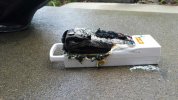
Recharging Drone Batteries Burns Fire Department to the Ground - Public Safety Flight
Over the years, I’ve written about the safety concerns surrounding the batteries we use for drones in public safety. A department shared their story and experience with me that should open your eyes if you continue to downplay the giant risks of charging your drone batteries. To show you I’m...
 psflight.org
psflight.org












